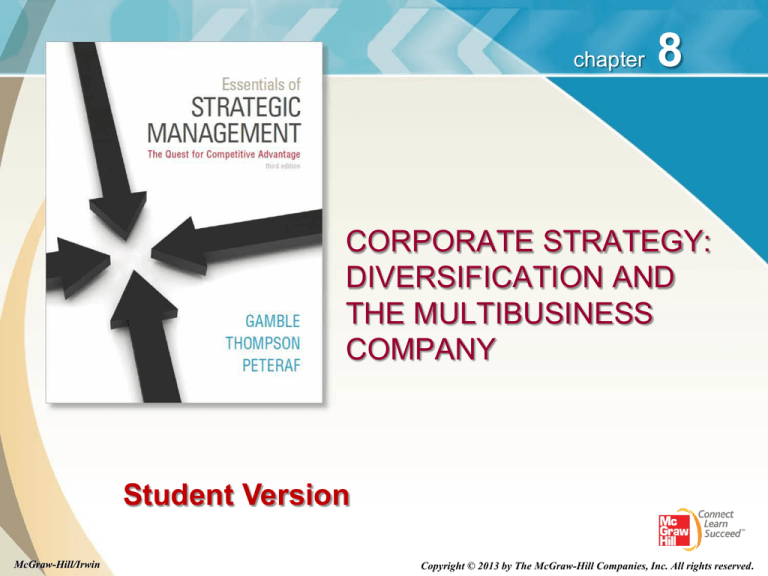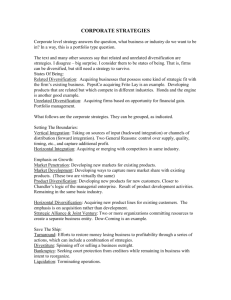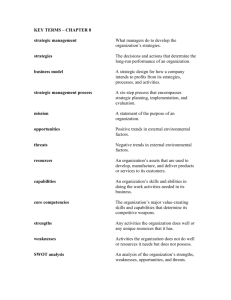
chapter
8
CORPORATE STRATEGY:
DIVERSIFICATION AND
THE MULTIBUSINESS
COMPANY
Student Version
McGraw-Hill/Irwin
Copyright © 2013 by The McGraw-Hill Companies, Inc. All rights reserved.
The Four Main Tasks in
Crafting Corporate Strategy
1. Picking new industries to enter and deciding
on the means of entry
2. Pursuing opportunities to leverage crossbusiness value chain relationships into
competitive advantage
3. Establishing investment priorities and steering
corporate resources into the most attractive
business units
4. Initiating actions to boost the combined
performance of the corporation’s collection
of businesses
8-2
When Business Diversification
Becomes a Consideration
Diversification is called for when:
There are diminishing growth prospects in the present business
An expansion opportunity exists in an industry whose
technologies and products complement the present business
Existing competencies and capabilities can be leveraged by
expanding into an industry that requires similar resource
strengths
Costs can be reduced by diversifying into closely related
businesses
A powerful brand name can be transferred to the products of
other businesses
8-3
Diversification by Acquisition
of an Existing Business
Most
popular approach to diversification
Advantages:
Quicker entry into target market
Easier to hurdle certain entry barriers:
Acquiring technological know-how
Establishing supplier relationships
Securing adequate distribution access
The
big dilemma is whether to pay a
premium price to buy a successful firm or to
buy a struggling firm at a bargain price
8-4
Entering a New Line of Business
through Internal Development
Is
more attractive when:
The parent firm already possesses the resources
needed to compete effectively.
There is ample time to launch a new business.
Internal entry will cost less than entry via acquisition.
The start-up does not have to compete head-to-head
against powerful rivals.
Adding capacity will not adversely impact supplydemand balance in industry.
Incumbent firms are likely to be slow or ineffective in
responding to an entrant’s efforts to crack the market.
8-5
Using Joint Ventures to Achieve
Diversification
A
good way to diversify when:
The expansion opportunity is too complex,
uneconomical, or risky to go it alone.
The opportunity in a new industry requires a
broader range of competencies and know-how than
an expansion-minded firm can marshal.
Drawbacks:
Potential for conflicting objectives
Operational and control disagreements
Culture clashes
8-6
Choosing the Diversification Path:
Related Versus Unrelated Businesses
Related
Businesses
Have value chains with competitively valuable
cross-business relationships that present
opportunities for the businesses to perform better
operating under the same corporate umbrella
than they could as stand-alone entities.
Unrelated
Businesses
Have value chains and resource requirements
that are so dissimilar that no competitively
valuable cross-business relationships are present.
8-7
The Case For Related Diversification
Strategic
Fit
Exists whenever one or more activities comprising
the value chains of different businesses are
sufficiently similar to present opportunities for:
Transferring competitively valuable resources, expertise,
technological know-how, or other capabilities from one
business to another.
Cost sharing between separate businesses where value
chain activities can be combined.
Brand sharing between business units that have common
customers or that draw upon common core competencies.
8-8
Strategic Fit and Economies of Scope
Stem directly from strategic fit along the value
chains of related businesses when costs can be
cut by:
Operating businesses under same corporate umbrella
Taking advantage of the interrelationships anywhere
along the value chains of different businesses
Advantage:
The greater the cross-business economies associated with
cost-saving strategic fit, the greater the potential for a related
diversification strategy to yield a competitive advantage based
on lower costs than rivals.
8-9
Diversifying into Unrelated Businesses
Involves
diversifying into businesses with:
No strategic fit
No meaningful value chain relationships
No unifying strategic theme
Strategic
approach:
Diversify through acquisition into any industry where
potential exists for enhancing shareholder value
through upward-trending corporate revenues and
earnings and/or a stock price that rises yearly.
While industry attractiveness and cost-of-entry tests
are important, better-off test is secondary.
8-10
Building Shareholder Value Through
Unrelated Diversification
Corporate
managers must:
Do a superior job of identifying and acquiring new
businesses that can produce consistently good
earnings and returns on investment.
Do an excellent job of negotiating favorable
acquisition prices.
Do such a good job overseeing and parenting the
firm’s businesses that they perform at a higher level
than they would otherwise be able to do through their
own efforts alone.
8-11
The Pitfalls of Unrelated Diversification
Demanding
Managerial Requirements:
1. Staying abreast of what’s happening in each
industry and each subsidiary.
2. Picking business-unit heads with the requisite
combination of managerial skills and know-how to
drive gains in performance.
3. Discerning the difference between strategic
proposals that are prudent and those that are risky
or unlikely to succeed.
4. Knowing what to do if a business unit stumbles and
its results suddenly head downhill.
8-12
The Pitfalls of Unrelated Diversification
Limited
Competitive Advantage Potential:
Unrelated strategy offers limited competitive
advantage beyond what each individual business can
generate on its own.
Without strategic fit, consolidated performance of an
unrelated group of businesses is unlikely to be better
than the sum of what the individual business units
could achieve independently.
8-13
Corporate Strategies Combining Related
and Unrelated Diversification
Dominant-Business Firms
One major core business accounting for 50–80% of revenues
and a collection of small related or unrelated businesses account
for the remainder
Narrowly Diversified Firms
Diversification into a few (2–5) related or unrelated businesses
Broadly Diversified Firms
Diversification includes a wide collection of either related or
unrelated businesses or a mixture
Multibusiness Enterprises
Diversification into several unrelated groups of related
businesses
8-14
Evaluating the Strategy of
a Diversified Company
Step 1: Assess the attractiveness of the industries the firm has
diversified into.
Step 2: Assess the competitive strength of the firm’s business
units.
Step 3: Evaluate the extent of cross-business strategic fit along
the value chains of the firm’s various business units.
Step 4: Check whether the firm’s resources fit the requirements
of its present business lineup.
Step 5: Rank the performance prospects of the businesses from
best to worst and determine a priority for allocating
resources.
Step 6: Craft new strategic moves to improve overall corporate
performance.
8-15
Step 1: Evaluating Industry
Attractiveness
Market size and
projected growth rate
Seasonal and cyclical
factors
Intensity of competition
Emerging opportunities
and threats
Social, political,
regulatory, and
environmental factors
Presence of crossindustry strategic fit
Industry profitability
Degree of uncertainty
and business
Resource requirements
risk
8-16
Step 2: Evaluating Business-Unit
Competitive Strength
Relative market share
Costs relative to competitors’ costs
Products or services that satisfy buyer expectations
Ability to benefit from strategic fits with sibling
businesses
Number and caliber of strategic alliances and
collaborative partnerships
Brand image and reputation
Competitively valuable capabilities
Profitability relative to competitors
8-17
Strategy Implications of the
Attractiveness/Strength Matrix
Businesses
in the upper left corner
Receive top investment priority
Strategic prescription: grow and build
Businesses
in the three diagonal cells
Are given medium investment priority
Some businesses have brighter or dimmer
prospects than others.
Businesses
in the lower right corner
Are candidates for divestiture or to be harvested to
take cash out of the business
8-18
Step 3: Determining the Competitive
Value of Strategic Fit in
Multibusiness Companies
Value
chain matchups offer competitive
value/advantage when there are:
Opportunities to combine the performance of
certain activities, thereby reducing costs and
capturing economies of scope.
Opportunities to transfer skills, technology, or
intellectual capital from one business to another.
Opportunities to share a respected brand name
across multiple product and/or service categories.
8-19
Step 4: Evaluating Resource Fit
A
diversified firm’s lineup of businesses
exhibits good resource fit when:
1. Each of a firm’s businesses, individually, strengthen
the firm’s overall mix of resources and capabilities
2. A firm has sufficient resources to support its entire
group of businesses without spreading itself too thin
8-20
Determining Financial Resource Fit
Use
a portfolio approach to determine the
firm’s internal capital market requirements:
Which business units are cash hogs in need of capital
funds to maintain growth and expansion?
Which business units are cash cows with capital
surpluses available to fund growth and reinvestment?
Assessing
the portfolio’s overall condition:
Which businesses are (or are not) capable of
contributing to achieving companywide performance
targets?
Does the firm have the financial strength to fund all of
its businesses and maintain a healthy credit rating?
8-21
Examining a Firm’s
Nonfinancial Resource Fits
A diversified firm must ensure that it can meet the
nonfinancial resource needs of its portfolio of
businesses:
Does the firm presently have or can it develop the specific
resources and capabilities (e.g., managerial talent, technology
and information systems, and marketing support) needed to be
successful in each of its businesses?
Are the firm’s resources being stretched too thinly by the
requirements of one or more of its present businesses?
Have recent acquisitions strengthened the firm’s collection of
resources or are they overtaxing management’s ability to
assimilate and oversee the expanded firm’s businesses?
8-22
Step 5: Ranking Business Units and
Setting a Priority for Resource Allocation
Factors
to consider in judging business-unit
performance:
Sales growth
Profit growth
Contribution to company earnings
Cash flow generation
Return on capital employed in business
8-23
Step 6: Crafting New Strategic Moves to
Improve Overall Corporate Performance
1. Stick with existing business lineup
and pursue opportunities it presents
2. Broaden the firm’s business scope by
making acquisitions in new industries
3. Divest some businesses and retrench
to a narrower base of business operations
4. Restructure the firm’s business lineup to
put a new face on its business makeup
8-24





